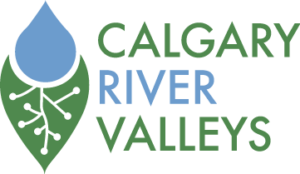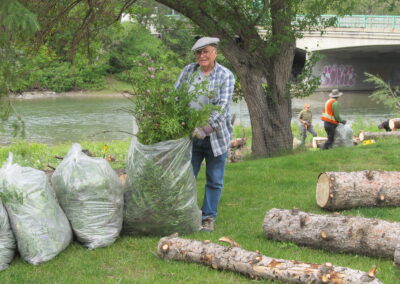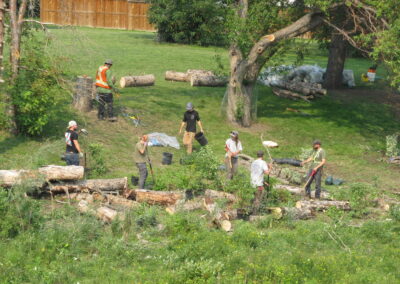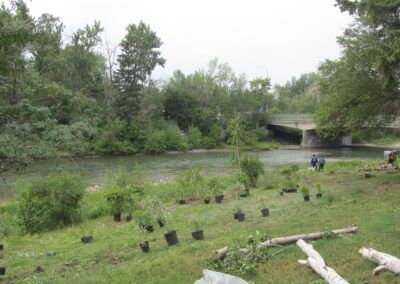Riparian Restoration
Riparian Restoration Projects
Calgary River Valleys has completed several riparian (river-adjacent land) restorations since 2018, along the Elbow River and West Nose Creek. We are currently working on our largest project yet, in Elbow Park. The first projects were mainly funded by the City of Calgary with a Watershed Planning grant. Subsequent years’ projects have been funded mainly by Provincial grant funding from the Watershed Resiliency and Restoration Program.
What is a Riparian Area & What Does It Do?
Riparian is from the Latin root, ripa, meaning bank, i.e. riverbank. A riparian area is the transition zone between the river and the rest of the land. It is a specialized area that has wetter soil than the surrounding land and will support water-loving vegetation. It can vary in width, depending on the width of the river or water body, as well as the slope of the surrounding lands. When the riparian area is healthy with a variety of deep-rooted vegetation it will prevent erosion of the riverbank, improve water quality by filtering run-off from the land and absorbing excess river sediment, reduce river energy during high water events, absorb high water and later release it (like a sponge), and provide excellent habitat for wildlife including shade for fish.
Most experts agree that hard surfaces on the riverbank like large bare rocks or retaining walls are not the best method of reducing the energy of floodwater as these can just rebound the water’s energy and damage another part of the riverbank. Also, the soil in between the rocks or underneath the wall can be washed away by floodwater, defeating its purpose. A better way to reduce the energy of floodwater and ensure the health of the riparian area is to have deep-rooted riparian plants along the river’s edge. However, if the retaining wall or large rocks can’t be removed, it would help to restore the health of the riparian area to plant deep-rooted plants adjacent to a retaining wall and in between the large rocks. During high water and flood events these types of plants help to absorb and reduce the force of the water, stabilize the riverbank, and prevent erosion.
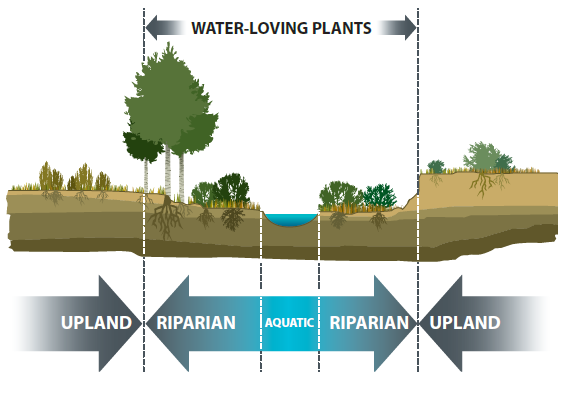
2023 Elbow Park Restoration:
Calgary River Valleys’ current “Riverbank Makeover” project involves restoring the riparian area & part of the upland area on 3 Province of Alberta owned properties in Elbow Park. For this project, we have contracted Leaf Ninjas to assist us with identification and removal of invasive weeds & aggressive non-native plants, selection and sourcing of native plants to revegetate the land, as well as an automatic watering system & maintenance of the site until end of summer 2024.
The type, size, and number of plants we intend to plant on this site are listed in the tables below.
Riparian Area Species
| Common Name | Latin Name | 5 Gallon Pot | 2 Gallon Pot | 1 Gallon Pot | Plugs | TOTAL # |
| Sandbar Willow | Salix exigua | 17 | 90 | 107 | ||
| Yellow Willow | Salix lutea | 17 | 17 | |||
| Balsam Poplar | Populus balsamifera | 17 | 17 | |||
| Red-Osier Dogwood | Cornus sericea | 9 | 20 | 18 | 23 | 70 |
| Chokecherry | Prunus virginiana | 7 | 19 | 17 | 22 | 65 |
| Silverberry | Elaeagnus commutata | 7 | 18 | 17 | 23 | 65 |
| River Alder | Alnus incana | 7 | 18 | 17 | 22 | 64 |
| TOTAL RIPARIAN | 30 | 75 | 120 | 180 | 405 |
Upland Area Species
| Common Name | Latin Name | 5 Gallon Pot | 2 Gallon Pot | 1 Gallon Pot | Plugs | TOTAL # |
| Golden Currant | Ribes aureum | 5 | 5 | |||
| Wood’s Rose | Rosa woodsii pedicel | 5 | 5 | |||
| Gooseberry | Ribes uva-crispa | 5 | 5 | |||
| Yarrow | Achillea millefolium | 20 | 20 | |||
| Harebell | Campanula rotundifolia | 20 | 20 | |||
| Meadow Blazing Star | Liatris spicata | 20 | 20 | |||
| Wild Bergamot | Monarda fistulosa | 20 | 20 | |||
| Cut-leaved Anemone | Anemone multifida | 20 | 20 | |||
| Three-flowered Avens | Geum triflorum | 20 | 20 | |||
| Early Yellow Locoweed | Osytropis campestris | 20 | 20 | |||
| Pussytoes | Antennaria | 20 | 20 | |||
| Blanketflower | Gaillardia aristata | 20 | 20 | |||
| TOTAL UPLAND | 0 | 15 | 0 | 180 | 195 |
Initial Elbow Park & Rideau Park Restorations:
Starting in 2018 and continuing in 2019, Calgary River Valleys completed two “Riverbank Makeover” projects with homeowners who back onto the Elbow River, with funding support from City of Calgary Water Services. These projects are in alignment with the City’s Riparian Action Program, which is designed to improve and maintain the health of river-adjacent areas as well as the quality and quantity of water flowing through Calgary’s rivers and creeks.
These project had 3 main components:
- Research about people’s knowledge of riparian issues,
- Field work to modify an Elbow River adjacent homeowner’s riparian zone with new vegetation and monitor its success over time, and
- Educate the public about the value and function of riparian zones in our ecosystem.
We have been monitoring the growth of the new plantings and the relative health of the riparian areas on these sites since they were restored.

Hidden Valley / Hanson Ranch Restorations:
In 2020 and 2022, we worked with Calgary Parks to plant native shrub species in a section of open space adjacent to West Nose Creek. Calgary River Valleys (CRV) staff and small group of volunteers planted approximately 700 sandbar willow stakes along part of the Hanson Ranch stretch of West Nose Creek in Hidden Valley. Subsequently, in 2022, CRV staff and volunteers planted an additional 120 pre-rooted shrubs in the same area. This restoration project was funded by our multi-year Watershed Resiliency and Restoration Project grant.
The intent of this project was to increase the number of native shrubs to better stabilize the creekbank, to make it more flood resilient, and to restore its natural functionality. We want to extend our thanks to City of Calgary Parks who provided permission to restore this area and facilitated the required permits. We will continue to monitor this project over time.
